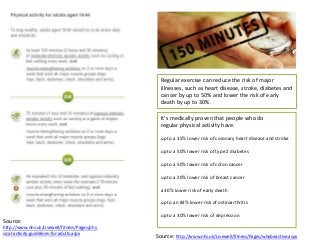
Research into topic
- 1. Regular exercise can reduce the risk of major illnesses, such as heart disease, stroke, diabetes and cancer by up to 50% and lower the risk of early death by up to 30%. It's medically proven that people who do regular physical activity have: up to a 35% lower risk of coronary heart disease and stroke up to a 50% lower risk of type 2 diabetes up to a 50% lower risk of colon cancer up to a 20% lower risk of breast cancer a 30% lower risk of early death up to an 83% lower risk of osteoarthritis up to a 30% lower risk of depression Source: http://www.nhs.uk/Livewell/fitness/Pages/phy sical-activity-guidelines-for-adults.aspx Source: http://www.nhs.uk/Livewell/fitness/Pages/whybeactive.aspx
- 2. Month on month growth since 2010 The chart shows the month on month comparison of average membership sales throughout the 2010-2011 year. You can see here how the recession shook the fitness industry. Source: http://www.clubmanagercentral.com/stats/ After almost a decade of expansion, the Gyms and Fitness Centres industry has hit a rut. Driven by rising disposable income levels, increasing health-consciousness and concerns about appearance; gyms and health clubs have signed up over 8.7 million gym members across the United Kingdom, which is about 17% of the adult population. Like the economy at large, poor performance has characterised the last few years, with lack of consumer confidence encouraging subdued performance. As such, industry expansion this year is only expected to advance a further 1.3%. Over the last five years industry revenue has increased at a rate of 1.2% per annum, totalling £777.2 million for 2012-13 Following several years of expansion during 2005-06 to 2008-09, industry growth began to slow as the recession caused a fall in discretionary spending on recreation. Gym-goers are looking for value from their memberships, with many trading down from premium health clubs to more basic and inexpensive fitness options. For some, this means switching to a cheaper plan or fitness club once membership renewal comes up, while others cancel their gym membership altogether. Source: http://www.ibisworld.co.uk/market-research/gyms-fitness-centres.html
- 3. ‘5 a day’ on a budget Eating plenty of fruit and vegetables doesn’t have to be expensive. There are lots of affordable ways to get your 5 A DAY. Buy fruit and vegetables loose rather than pre-packaged. Loose fruit and veg can be as little as half the price. Look for supermarket deals on fruit and vegetables, such as buy one get one free offers. Fruit and vegetables are usually cheaper if they're in season. The latest research shows that in England over 60% Fruit and vegetables are often cheaper at your local street or of adults are overweight or obese. That means farmers' market. many of us are eating more than we need, and need Replace your morning or afternoon snack with a piece of fruit. A to eat less. banana or an apple costs around 20p at the supermarket, about half the price of most chocolate bars or packets of crisps. The savings add up and so do the health benefits. As a guide the average man needs around 2,500 Look for good deals on frozen and dried fruit and veg, such as frozen peas and dried pulses and beans. They are often cheaper calories a day to maintain a healthy body than fresh varieties. weight, and the average woman needs around Swap ready meals for homemade alternatives. Vegetables in 2,000 calories a day. dishes such as stews, bakes, casseroles and curries count towards your 5 A DAY, and cooking these dishes yourself is cheaper than buying them ready-made if you are very physically active because of the type of job you do, or you are a professional athlete, you may need more calories than this to maintain a healthy weight. If you do very little physical activity – for example, you are overweight or obese, you may need fewer calories Source: http://www.nhs.uk/Livewell/Goodfood/Pages/eat-less.aspx Source: http://www.nhs.uk/Livewell/5ADAY/Pages/5ADAYontherun.aspx
- 4. Source: http://www.realbuzz.com/articles/is-your-lifestyle-holding-your-exercise-back-gb-en/ Is your lifestyle holding your exercise back? Busy modern lifestyles have resulted in a rise of fast food consumption and car usage and a lack of exercise and physical activity. However, there are ways to beat today’s lack of health and fitness exercise. Here’s our guide to improving your fitness through exercise fitted around your daily life. The car is king over exercise Despite high running costs and congestion; car use and ownership has never been more popular. Shopping centres are increasingly sited ‘out of town’ to cater for close parking and we routinely travel distances in cars that are perfectly walkable. The result is that we are less fit in both our cardiovascular systems and general leg strength. Additionally, our calorie burn is reduced, making weight management more difficult. Supermarket growth and bad nutrition Walking to the bakery for a loaf of bread is almost a thing of the past these days. The growth in supermarkets as a one-stop-shop has been immense, as has the trend towards supermarket prepared convenience foods. Typical hectic lifestyles have resulted in home cooking taking a broadside and microwave meals increasing in popularity. Convenience foods are often high calorie, low nutrition versions of regular meals, further adding to health and fitness problems. Fast food thwarting exercise In line with the rapid pace of the 21st century, fast food outlets have boomed. Unfortunately, the nutritional content of a great many of these fast food products is extremely low, yet also extremely calorific. A typical ‘burger, fries and soft drink’ meal can easily contain more than half of a person’s calorie requirements for one day — in a single meal.